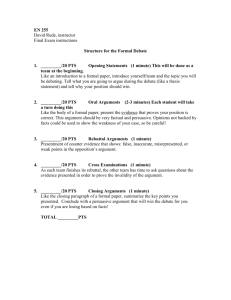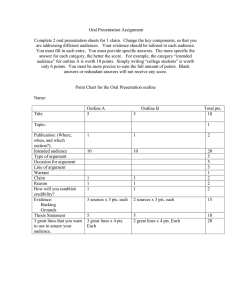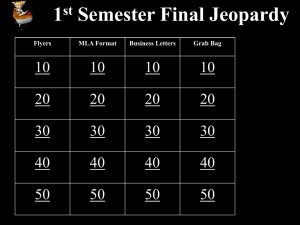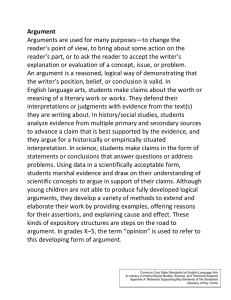RWS 100: Rhetoric of Written Argument Instructor Rhonne Goodman Fall 2013
advertisement
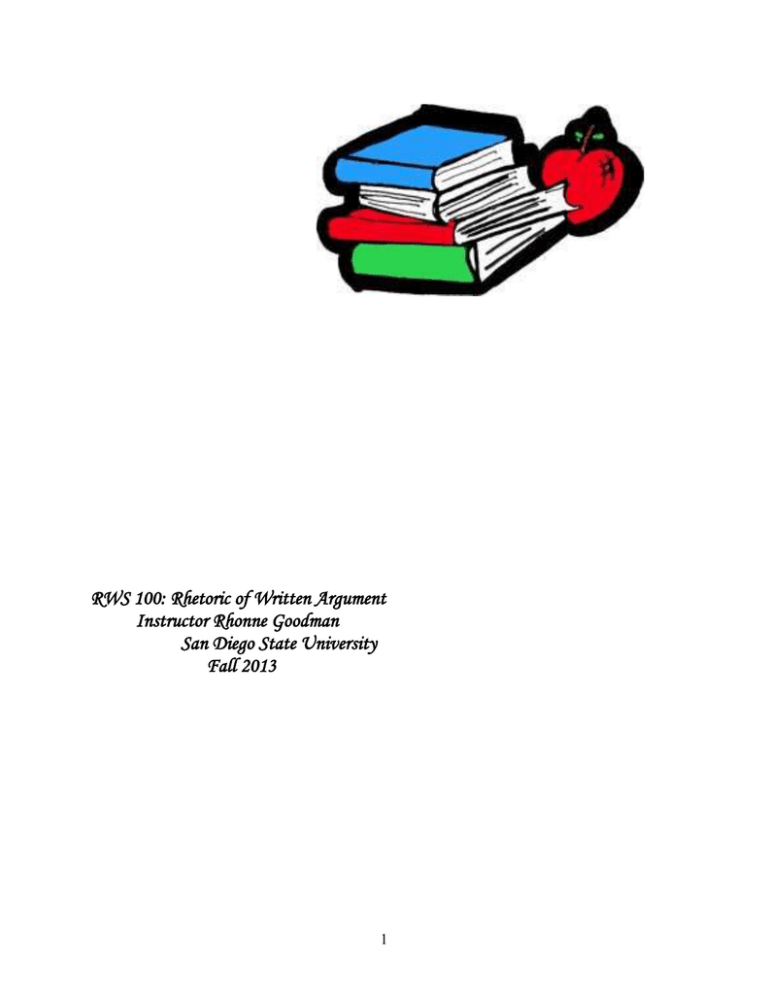
RWS 100: Rhetoric of Written Argument Instructor Rhonne Goodman San Diego State University Fall 2013 1 RWS 100: Rhetoric of Written Argument Table of Contents Topic Page Instructor Information 3 Catalog Description 3 Required and Recommended Materials 3 Course Objectives and Requirements 3 Attendance 3 Cell Phones/food 3 Late Work 3-4 Plagiarism 4 Point Adjustments 4 Electronic Submission 4 Performance Evaluation 4 Special Needs 4 Important Number 4 MLA Format (the basics) 5-6 Discussion Boards 7 Outside Research 7 Points 8 Evaluation of Essay Rubric 9 - 10 Assignment #1 – Construct an Account/Analysis of an Argument 11 N/A Assignment #2 – Gathering Information and Managing Sources 12 N/A Assignment #3 – Explaining Rhetorical Strategies 13 N/A Student Outcomes 14 - 15 Calendar 16 – 17 N/A 2 RWS 100: The Rhetoric of Written Argument Instructor: Office Hours: Office Mailbox: E-mail Address: Rhonne Goodman AH 3183, 12:00-12:45 am MTWTH and by appointment DRWS Office – Adams Humanities - AH 3138 rgoodman23@hotmail.com “I love being a writer. What I can’t stand is the paperwork.” -Anonymous Catalog Description: “Emphasizes reading and writing principles and practice of effective, logical and precise expression of ideas. Students will be required to write a variety of papers applying basic rhetorical patterns” SDSU catalog. Additionally, you will become familiar with library research and standard MLA format. Required Textbooks: Goodman, Rhonne. RWS 100/101 Course Reader, San Diego: Montezuma Publishing, 2013. Raimes, Ann. Keys for Writers, 4th ed. United States: Wadsworth, 2013. (Picture of San Diego State on the Cover) Highly Recommended Materials: $4-7 dollars for copies of papers, a copy card w/balance is advised. Access to a computer since all outside papers are typed. Pen and paper for in class writings, no tear outs. Course Objectives and Requirements: The course will begin with you examining various readings, where you will explore the concepts of argument: understanding the audience, intentions, structures, and rhetorical appeals. During the course of the semester we will be reading selections from RWS 100/101 Course Reader, and you will be asked to write three essays outside of class drawing from the text. We will be using MLA format for all papers using Keys for Writers, MLA section. All submitted assignments must be typed and double spaced using no larger than a 12-point font. This syllabus is a great way to measure since it is formatted in the largest print that will be acceptable, Times New Roman. You will also be expected to compose reading responses, a revision of one paper, in-class timed writings (ICE), homework assignments, précis and outside research, as well as participate in writing workshops. Attendance: Attendance is important since many of these activities are graded in-class assignments and cannot be made up. Participation points are approximately 5% of the final grade. Deductions after three scheduled class hours missed at 5 pts. each. (Classes meeting 3x week-3 absences, 2x week-2 absences, 1x week-1 absence) Cell Phones/food: Please turn off cell phones and pagers. Leaving to answer your phone or texting will result in you being marked absent with no readmittance for the day. No food/eating in class. Late Work: I do not accept late work unless under extreme circumstances. Being absent is not 3 an excuse for late work. I am human but I have also been around. I will always take work early. Please plan ahead. Plagiarism: According to the American Heritage Dictionary, the definition of plagiarizes is as follows: “To steal and use (the ideas or writings of another) as one’s own.” This is a serious offense and can result in not only a failing grade, but also investigatory activity by the college that could result in expulsion. Check official SDSU policy. Warning: All papers will also be submitted electronically through Blackboard and accompanied by hard copy. Point Adjustments: Although I can appreciate the frustration of missing a final grade by one or two points, before you contact me, please look at a few things first. Did you miss turning in a small (5 pts) assignment that would have made the difference? Did you see that you didn't get full points on those assignments and not bother to find out how to get more points? Earned grades are just that, earned. I do not revisit things because you are 2 points shy of the next grade, or didn't do them. I take grading very seriously. Please do not contact me about any grade changes. I do not “round up” blackboard grades, nor do I give extra credit after grades are posted. Please keep track of your paper/assignment points. You are responsible for checking Blackboard for the accuracy of your entered points. Although I try to be as accurate as possible, I am human. Mistakes not reported by the last week of class will be considered correct. Electronic Submission: All 100 point Final Draft papers will be submitted in hard copy AND electronically submitted in Microsoft Word format. No exceptions. Deduction of 10 pts. for missed or incorrect submissions. Go to Blackboard, click Assignments, click the link for the paper. Attach and submit. Check gradebook for an exclamation point to confirm submission. I’ll evaluate your performance according to: The quality of your written work. The quality of your preparation for such activities as reading assignments, writing assignments and your responses to the text. Participation in class discussions and activities. The general quality of your responses to the readings and indications that you understand and are involved with the material. I expect you to: Show up. Be forewarned: the class is structured so that if you don’t do the in-class assignments your chances of getting a good grade or even passing are pretty slim. Be on time. I will not repeat what I have already covered. You are responsible for getting any missed information. Treat each other with respect. At a college or university, we discuss things as adults, we exchange ideas, we ask questions, we go on quests, and we listen. We don’t fight, we don’t name call, and we don’t throw things at each other. Read the assigned readings. If you don’t read them, you can’t write about them. Write. This will require a lot of work. If you hope to take this class without doing a lot of writing then I suggest you find another section. Get your assignments done on time. Special Needs: Students with disabilities who may need Academic accommodations should discuss options with their Professor during the first two weeks of class. Important number: Campus Police (619) 594-1991, please add this number to your cell phone. 4 Your Last Name Only 1 Student Name (First Last) Professor Rhonne Goodman RWS 100 Day Month Year (10 September 2013) Your Title Here Here’s a way to appease future English instructors (not to mention any other instructor in the humanities) by putting all typewritten papers in MLA format. (MLA stands for the Modern Language Association, an organization of teachers and scholars formed over a century ago whose goal was not to make your life miserable, but to facilitate the inclusion of modern languages in academia alongside those other established languages, like Latin and Greek.) It is one of the simplest ways to make a good first impression and requires nothing more than learning a few simple rules. First of all, always use a normal, 12-point font, throughout your paper. Times New Roman, which is being used here, is my choice. Use the same font and size consistently throughout your paper – no big fonts for titles, no bold words for emphasis (or titles) and no fancy fonts for fun or to be cutesy. Underlines or italics should only be used for titles of complete works, like books and movie titles. If you underline a title in your paper, underline in Works Cited or if you use italics in the paper, then use italics in the Works Cited, do not mix and match. Quotation marks should be used for titles of smaller works, such as articles, poems, song titles, and short stories or parts of a bigger whole, such as “chapters” from a book. The rules may vary depending on the work in question, so consult your instructor or a current handbook with (Do not number pages at the bottom) 5 Your Last Name Only 2 MLA format for any other concerns. Second, double space your document consistently from beginning to end. Do not add extra lines before or after a title or between paragraphs (To remove the extra in between paragraphs: Home – paragraph – spacing, set 0 in before and 0 in after). Do not single space block or indented quotes (more information about this is also available in most grammar books). Double space everything. In Word (2003 or 2007), you set the spacing by looking under the “Format” window and choosing “Paragraph.” Find the box that says “Line Spacing” and set it to “Double” (This can also be done after you have completed the paper, by going to “Edit” then “Select All” and then resetting the line spacing). Margins should be one inch all the way around the paper (go to “File” then “Page Setup”). Double spacing for Word 2010 and 2012 is under the Home tab in the Paragraph formatting section, and to set margins go to “Page Layout”. Finally, remember to set a header, this is your last name and the page number on the top right hand corner of each and every page. In Word (2003 or 2007), go to “View” and select “Header and Footer.” Click the right-justify box, and then type in your last name and a space. Do not type in a page number. Instead, click the little box with #. This will automatically number your pages. In Word 2010 and 2012, go to Insert and select Header. Type in your last name on the right side in the box and a space and click the Page number box. There are plenty of other aspects to MLA format (such as use of numbers, quotes, and citations), that you can find listed in most grammar books. Some good suggestions for grammar books are Keys for Writers by Ann Raimes and Rules for Writers by Diana Hacker. Following these simple steps will allow you to present your papers in a recognizable, professional format. (Do not number pages at the bottom) Yoder/Ball/Goodman 2011 6 For the Discussion Board, worth up to 10 points, you will be graded as follows: 1. (A) An “A” post will be a thoughtful comment on the question posed. It will stay on topic and respond thoroughly to the question citing the reading when applicable. The “A” student will also take time to constructively comment/critique on 1 of their peers’ work/ideas in a tactful manner, and even provide further ideas/questions for exploration. 10 pts. 2. (B) A “B” post is a good post, but it is not excellent. The student makes thoughtful comments, responds to 1 other post, but may have trouble in clearly putting thoughts in an organized, easy to understand manner. A “B” student may veer off topic slightly. Spelling or grammar issues can keep a “B” post from becoming an “A.” 8 pts. 3. (C) A “C” post is average. The student responded either briefly to the question, did not respond completely to the question, was not able to apply textual analysis to the response, did not create a thread or respond to other posts, or there were grammar/syntax issues that impeded the understanding of the post. 7 pts. 4. (D) The “D” post would be earned by a student who attempts a post, or simply reacts to it, but fails to clearly respond to the topic posed or does not respond to his peers’ comments. 6 pts. 5. (F) A student who earns an “F” failed to post to the discussion board, merely “reacted” to the topic at hand, and/or was rude/disrespectful to their peers, submitted no response to other posts, incorrectly posted only a thread or a response, not both. 0-5 pts. Postings must be 75 – 100 words (a short paragraph) and not stray off topic. Repetitive responses (where a student says the same thing as a response) will not be considered for grades. There are five Discussion Boards worth up to 10 pts. each (50 points total). They are open on the first day of class and will close before the start of class on the due date (8:00 am class/8:00 am close). No late submissions accepted. 7 Outside Research Assignments – Two Parts: Research + Write-up = 1 Grade (0-10 pts.) All research assignments will connect to either future papers or to topics currently being discussed. The assignments will consist of two parts, the first part is a one page (minimum), typed reaction/response to the research, and the second part is the actual research. You must turn in both sections to receive credit. Portions left on printers, at home, or forgotten as a second component will not be accepted late. Please do not ask to email the parts that you do not have. 1. Prepare a one-page, typewritten response of the assigned research. These short essays will receive one combined letter grade based on a 5 point scale; they will be evaluated on the basis of substance, clarity, organization, and mechanics. One full, typed page is the minimum requirement. 2. A response is not a summary. This is a personal response to the research content and to the way the articles are written. How the information is presented and the audience it is intended to reach. How the author’s style might present their view points or attract the attention level of the reader is important. Responses of; “I really liked it” or “It was really good” or “It really got my attention” are not really an analysis of the work. This response requires you to analyze and then evaluate the analysis. * All parts are due at the start of class. Missing pieces are not accepted late. _____________________________________________________________________________________ Points: Essays 3 @ 100pts. each Discussion 5 @ 10 pts. each Outside Research 5 @ 10 pts. each Participation Final Total = 300 = 50 = 50 = 25 = 25 450+ (+ additional points may be assigned) Please keep track of your paper/assignment points. You are responsible for checking Blackboard for the accuracy of your entered points. Although I try to be as accurate as possible, I am human. Mistakes not reported by the last week of class will be considered correct. (Please note Point Adjustments, page 4). 8 EVALUATION OF ESSAYS Name: ______________________________________________ Point Values: Scale: outstanding/superior 90-100 = A-/A strong/above average 80-89 = adequate/average 70-79 = weak/below average 60-69 = unacceptable/failed/ 00-59 = non-existent B-/B+ C-/C+ D-/D+ F Circling of an item indicates deficiency—ESPECIALLY WORK ON THIS; Underlining indicates excellence—ESPECIALLY GOOD WORK HERE. 1. PURPOSE: 20 15 10 5 0 Overall: Paper responds to topic and/or aim asked in assignment. Topic is stated. Introduction: Lead-in arouses interest; thesis statement has controlling idea establishing clear focus for whole paper; set up is given for major aspects/points to be developed. Body: Development of overall controlling idea maintained throughout. Conclusion/Evaluation: Connection is made back to overall idea and it significance. 2. ORGANIZATION: 20 15 10 5 0 Overall; Paper responds to pattern of organization asked in assignment, if given; paper has introduction, body of main points (three or more), and conclusion; points in body relate to overall thesis; points are presented in logical and appropriate sequence; points are given balanced amount of development. Paragraphs in body; each is focused on one main point, having a topic sentence with a controlling idea; support connects to topic sentence and has logic to sequence presented. Transitions: Connection of ideas is made between paragraphs; connection is made between aspects of development within paragraphs to create smooth flow of thought. Research; Research material has direct connection with the thesis; research material is used logically in development; research is integrated smoothly integrated into the presentation. 3. CONTENT: 20 15 10 5 0 Paper responds to assignment and reflects understanding of material. Thesis not superficial or obvious about topic but shows thought, maturity, and perceptiveness. Points for development divide overall idea into significant aspects. Development of each point has depth, going past generalities to specifics of background, reasons, analysis, evidence, including quotes as appropriate and/or examples and illustrations for support, clarity, informativeness, and interest. Basis of authority for statements is made clear, including credibility of sources established, as appropriate. Research material is interpreted and discussed adequately; paraphrases and quotes are introduced and clearly distinguished from the writer's own style; number of sources is sufficient to provide different viewpoints; quotes are well chosen and integrated (smoothly worked into the writer’s own sentences);the writer's own sentences; research supports and clarifies writer's thesis, is appropriately selected, and accurately cited. 4 STYLE: 20 15 10 5 0 Paper responds to assignment for intended audience and tone. Opening catches interest. Paper overall reflects voice of person who wrote it, showing interest and involvement of the writer, not sounding mechanical. Audience for paper is treated with respect. Thesis and set up are stated as assertions about the topic to show what will be developed rather than statements about the writer or the paper. Dominant tone is reasonableness, avoiding emotionalism. 9 Flow of ideas is smooth and engaging. Sentences have variety of structures for rhetorical effectiveness. Imagery is created and appeals to variety of senses. Summary and Clichés are avoided. Diction is accurate and appropriate for purpose of paper and assumed audience. Academic 3rd person is used. First person is used only when allowed or appropriate. Final sentence gives paper a finished sound. Avoids repetition. 5. TOTAL IMPRESSION: 20 15 10 5 0 Paper responds to all (or almost all) aspects of assignment. Everything, including research, works together effectively. Paper has overall professional appearance. Paper maintains interest and effectiveness throughout. Incorrect or lack of Electronic submission will lose the paper one full grade (-10 pts) with no adjustment. ______________________________________________________________________________________ 6. MECHANICS: -5 -10 -15 -20 AUTOMATIC F* Major errors or combination of minor errors in Standard English spelling, punctuation, and grammar. Occasional or continual sentence structure problems Major errors involve any of the following: sentence fragment, comma splice or run-on sentence, dangling modifier, subject-verb agreement error, pronoun case or agreement error, incorrect use of common sound- alike words (e.g. its/it's; there/their/they're; your/you're). Also detracting from the paper's merit are any of the following: careless typing and/or poor proofreading; incorrect heading format; incorrect heading, lack of title, writer's name, course, etc.; margins wider than 1"; lack of or improper format for appropriate documentation of sources; lack of citations or improper format for Works Cited page; lack of or improper format for in-text citations; lack of sufficient length of paper (additional -10 pts.). sources are appropriately signed and attached, if requested. *If AUTOMATIC F is circled, you MUST correct the mechanics of your paper. Retype the paper and submit the revision WITH the original and this evaluation sheet to get the grade restored that you would otherwise have earned. If you wish to increase that grade; you must also revise the content and organization of your paper. INADEQUATE RESEARCH: ____________________ GRADE FOR PAPER: ____________________ LC:rg 08/01/13 Revised Paper #1 (grade of 89 or less) must be turned in with original attached, otherwise current grade remains. 10 RWS 100 Student Learning Outcomes General Education Capacities/Goals & RWS Learning Outcomes Our Learning Outcomes Reflect the Goals and Capacities of the General Education Program. RWS 100 is one of several courses in the area of general education defined as “Communication and Critical Thinking.” Focusing particularly on argument, this course emphasizes four essential general education capacities: the ability to 1) construct, analyze and communicate argument, 2) contextualize phenomena, 3) negotiate differences, and 4) apply theoretical models to the real world. This course advances general education by helping students understand the general function of writing, speaking, visual texts, and thinking within the context of the university at large, rather than within specific disciplines. In addition to featuring the basic rules and conventions governing composition and presentation, RWS 100 establishes intellectual frameworks and analytical tools that help students explore, construct, critique, and integrate sophisticated texts. Within this framework of four general capacities, the course realizes four closely related subsidiary goals. These goals focus on helping students 1) 2) 3) 4) craft well-reasoned arguments for specific audiences; analyze a variety of texts commonly encountered in the academic setting; situate discourse within social, generic, cultural, and historic contexts; and assess the relative strengths of arguments and supporting evidence. Assignment Types: the following four outcomes describe the four main writing projects or "assignment types" for the course. Students will be able to: 1. Describe and analyze an author’s argument, claims, project, support and rhetorical strategies. 2. Construct an account of an author’s project and argument and carry out small, focused research tasks to find information that helps clarify, illustrate, extend or complicate that argument; use appropriate reference materials, including a dictionary, in order to clarify their understanding of an argument. 3. Construct an account of one or more authors’ projects and arguments and explain rhetorical strategies that these authors—and by extension other writers—use to engage readers in thinking about their arguments. 4. Construct an account of two authors’ projects and arguments in order to use concepts from one argument as a framework for understanding and writing about another. Outcomes across the semester: the following points describe outcomes to work on throughout the semester, to be attained over the 15 weeks. Students will be able to: 5. describe elements of an argument--claims, methods of development, kinds of evidence, persuasive appeals; annotate the work that is done by each section of a written argument; 6. use all aspects of the writing process--including prewriting, drafting, revising, editing, and proofreading; 11 7. choose effective structures for their writing, acknowledging that different purposes, contexts and audiences call for different structures; understand the relationship between a text's ideas and its structure; 8. identify devices an author has used to create cohesion or to carry the reader through the text; use metadiscourse to signal the project of a paper, and guide a reader from one idea to the next in their writing; 9. effectively select material from written arguments, contextualize it, and comment on it in their writing; 10. determine when and where a source was published, who wrote it and whether it was reprinted or edited; understand that texts are written in and respond to particular contexts, communities or cultures; examine the vocabulary choices a writer makes and how they are related to context, community or culture, audience or purpose; 11. respond in writing to ideas drawn from various cultures and disciplines, using the activity of writing to clarify and improve their understanding of an argument; 12. analyze and assess the relative strengths of arguments and supporting evidence 13. analyze and assess arguments made by visual texts; incorporate visual images into their documents; 14. craft well reasoned arguments for specific audiences 15. edit their writing for the grammar and usage conventions appropriate to each writing situation; 16. assign significance to the arguments that they read; 17. reflect on how they wrote their papers, and revise arguments and findings based on critical reflection. 12
